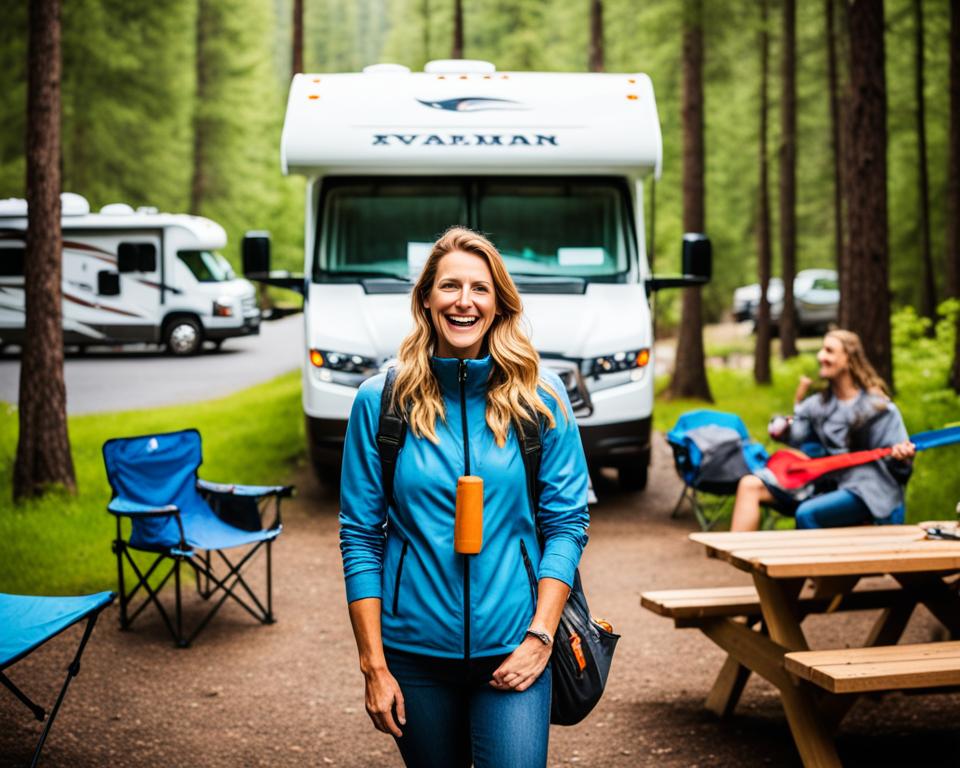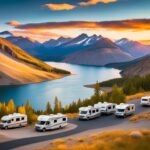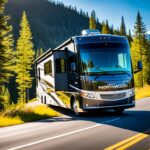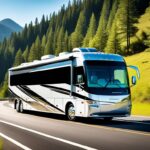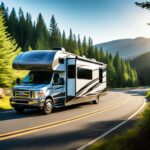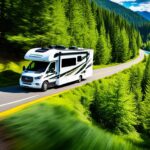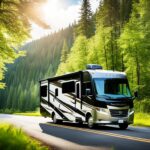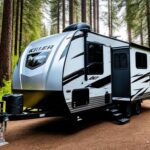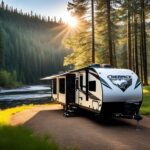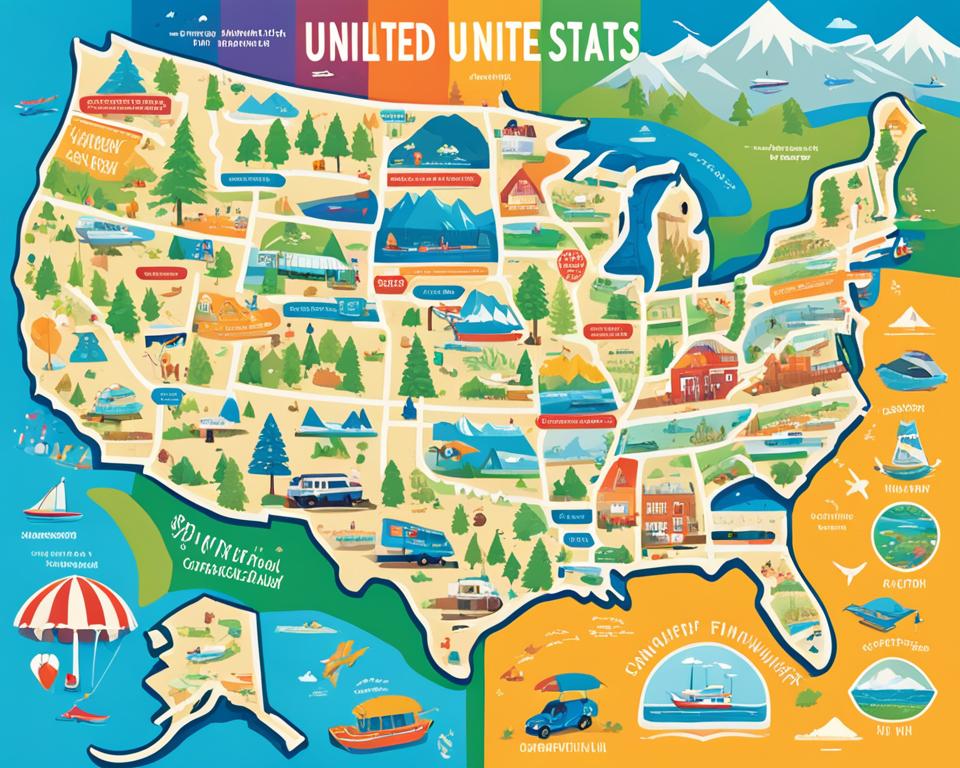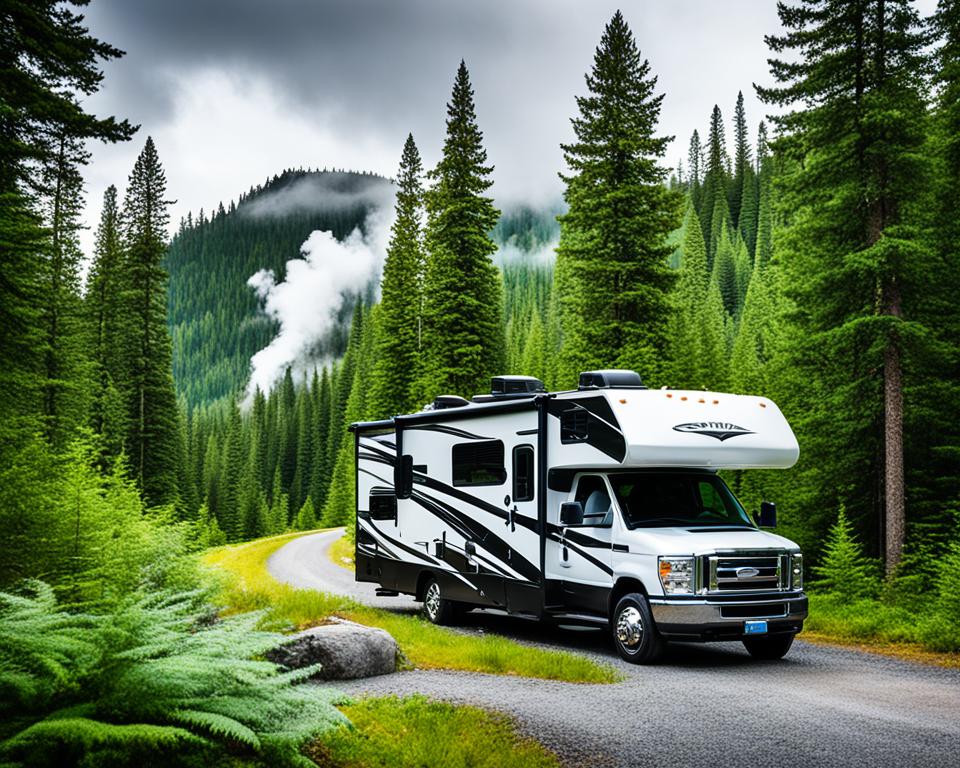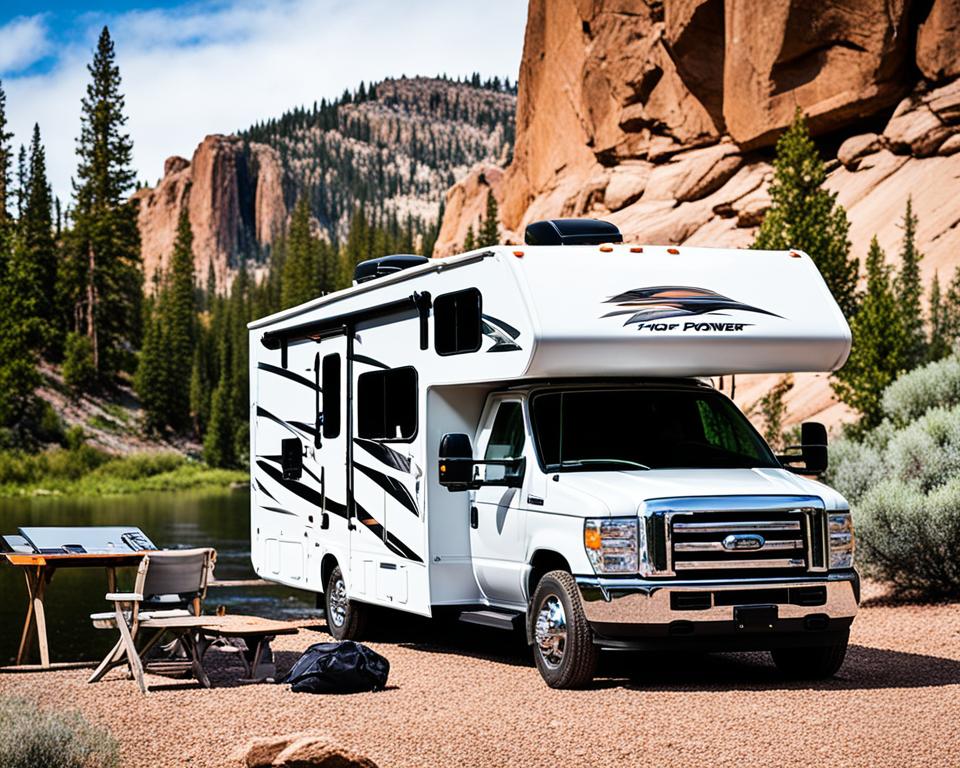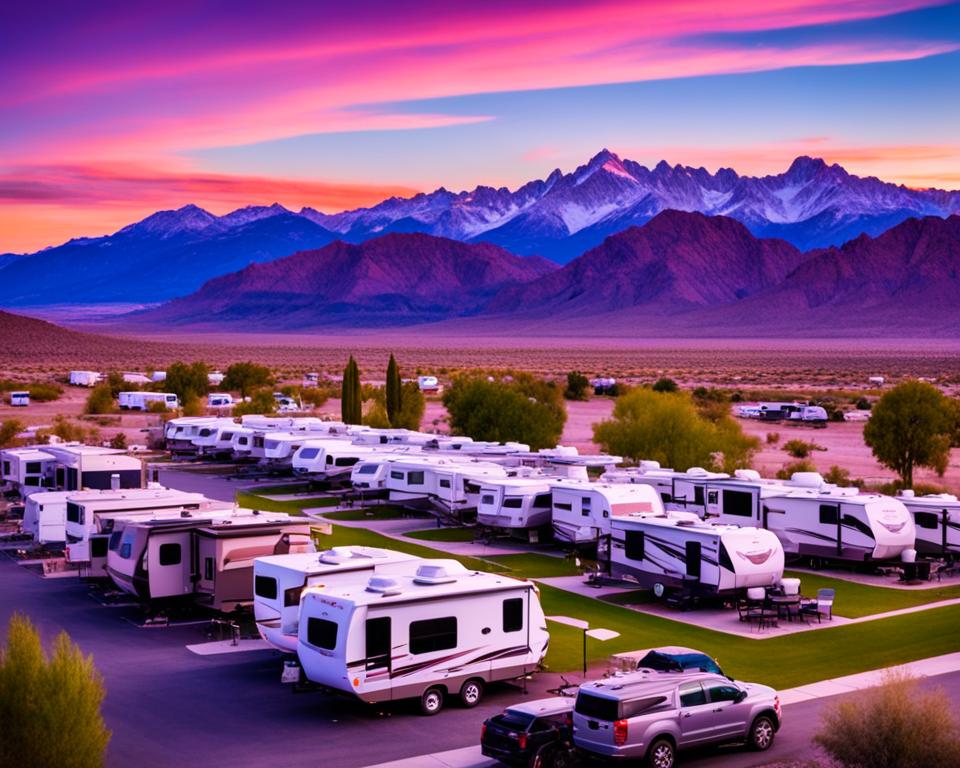RV camping offers a unique outdoor experience where travelers can embark on memorable adventures. Whether you’re a seasoned RVer or new to the world of RV camping, this ultimate guide has all the information you need to plan the perfect trip.
From finding the best RV campsites to essential tips and gear, we’ve got you covered. Discover stunning destinations, learn about RV camping essentials, and get insider advice from experienced campers. Whether you prefer exploring national parks, relaxing near lakeshores, or venturing off the beaten path, RV camping provides endless opportunities for adventure.
So, pack up your RV and get ready to hit the road! Whether you’re searching for the best RV campsites, seeking tips on RV camping essentials, or looking for inspiration on where to go, this ultimate guide will be your go-to resource for an unforgettable RV camping adventure.
Key Takeaways:
- Find the best RV campsites for your camping adventure.
- Learn about essential RV camping tips and gear.
- Discover top RV camping destinations.
- Plan your RV camping checklist to ensure a smooth trip.
- Get expert advice on RV camping near me options for convenience.
Discovering Dispersed Camping
One option for RV camping is dispersed camping, also known as boondocking. This type of camping allows you to camp outside of designated campgrounds on public lands managed by agencies like the Bureau of Land Management (BLM) or United States Forest Service (USFS). Dispersed camping offers the opportunity for more privacy and stunning scenery.
Unlike traditional campgrounds, dispersed camping allows you to find your own spot amidst breathtaking natural landscapes. Whether it’s nestled among towering trees in a national forest or perched on the edge of a crystal-clear lake, the possibilities are endless.
To get started with dispersed camping, it’s important to familiarize yourself with the rules and regulations set by the managing agencies. These regulations vary depending on the location, so it’s crucial to do your research beforehand. Respect for the environment and other campers is essential to preserve the beauty of these public lands.
When finding dispersed campsites, there are a few strategies you can employ. Online resources like campsite finding apps and websites can be valuable tools. Additionally, speaking with local rangers or fellow outdoor enthusiasts can provide insider tips on lesser-known spots. Remember, the journey is as important as the destination, so be prepared to explore and discover hidden gems along the way.
By opting for dispersed camping, you’ll have the opportunity to immerse yourself in nature and enjoy a sense of freedom that comes with being surrounded by wide-open spaces. So pack your gear, fuel up your RV, and embark on an unforgettable adventure into the heart of public lands camping.
Navigating the Rules and Regulations
Before setting out for your dispersed camping adventure, it’s crucial to understand and comply with the rules and regulations set forth by the managing agencies such as the BLM and USFS. These regulations aim to protect the environment and ensure a positive experience for all campers. Here are a few key points to consider:
- Respect fire regulations: Check for any fire restrictions or bans in the area you plan to camp. Always follow proper fire safety protocols and be mindful of the potential impact your campfire may have on the surrounding environment.
- Stay within designated areas: While dispersed camping allows for greater flexibility in choosing a campsite, it’s important to camp only in designated areas to minimize ecological impact and protect sensitive habitats.
- Leave No Trace: Embrace the Leave No Trace principles and practice responsible camping. Pack out all your trash, dispose of waste properly, and leave the campsite as you found it. By practicing Leave No Trace ethics, you contribute to the preservation of these public lands for future generations.
“Dispersed camping offers a unique opportunity to disconnect from the hustle and bustle of everyday life and reconnect with nature. Whether it’s waking up to the sound of birds chirping or stargazing under a clear night sky, boondocking provides a sense of freedom that is hard to replicate in traditional campgrounds. It’s a chance to create memories that will last a lifetime.”
Finding the Perfect Dispersed Campsite
When it comes to RV camping in the great outdoors, finding the perfect dispersed campsite is key. Whether you’re a seasoned outdoor enthusiast or a novice adventurer, choosing the right campsite can make all the difference in your camping experience. Here’s a guide to help you narrow down your options and find the ideal campsite that suits your preferences and needs.
Choosing a Campsite
Before embarking on your RV camping trip, take some time to consider what factors are important to you in a campsite. Do you prefer a spot near water for fishing or swimming? Are you looking for easy access to hiking trails? Is cell service a priority for you? By identifying your preferences, you can narrow down your search and focus on campsites that meet your specific criteria.
Mapping Platform
One of the best tools for finding dispersed campsites is a reliable mapping platform that provides accurate information about public lands. Gaia GPS is a popular mapping platform that allows you to identify public lands and explore potential campsites. It provides detailed maps, trail information, and even off-grid navigation features to help you find your way.
Online Resources
In addition to mapping platforms, there are several online resources that can assist you in finding dispersed campsites. Websites like Campendium, FreeCampsites, iOverlander, and The Dyrt offer comprehensive databases of campsite locations, detailed information on amenities and access, and reviews from fellow campers. These resources can give you valuable insights and recommendations to help you make an informed decision.
| Mapping Platform | Features |
|---|---|
| Gaia GPS | – Accurate maps and trail information – Off-grid navigation features – Ability to identify public lands and campsites |
Road Conditions and Considerations
When planning an RV camping trip to dispersed campsites, it’s important to take road conditions into consideration. These campsites are often accessed via dirt roads, and the conditions can vary greatly. Before embarking on your adventure, it’s crucial to research your destination and determine whether your RV is capable of navigating rough roads.
High-clearance RVs: If you’re planning on exploring rugged terrains, it’s recommended to choose a high-clearance RV. These vehicles are designed to handle uneven surfaces and obstacles with ease, providing you with a smoother and more comfortable journey.
Smaller trailers: Maneuverability is another important factor to consider. Smaller trailers offer greater flexibility when navigating tight corners and narrow paths. They are also easier to park, making it simpler to find the perfect camping spot.
However, even with the right RV or trailer, it’s always wise to be prepared for unexpected road conditions. One useful item to have in your arsenal is traction tire mats. These mats provide additional grip and traction, which can be extremely helpful if you encounter sandy or muddy terrain along the way.
To sum it up, when heading to dispersed campsites, keep in mind that road conditions can vary. Choose a suitable RV or trailer that can handle rough terrains, opt for a high-clearance RV for challenging roads, consider the maneuverability of a smaller trailer, and always carry traction tire mats for added peace of mind.
Rules and Regulations for Dispersed Camping
When it comes to dispersed camping, it’s important to be aware of the camping regulations and adhere to the principles of Leave No Trace ethics. Each land manager, such as the Bureau of Land Management (BLM) or the United States Forest Service (USFS), has different rules and guidelines in place to ensure the preservation of these public lands and the enjoyment of all visitors.
Camping Regulations
Before embarking on a dispersed camping adventure, it’s crucial to familiarize yourself with the specific camping regulations of the land management agency overseeing the area you plan to visit. These regulations may include limitations on the duration of your stay, campfire restrictions, waste disposal guidelines, and any permits or fees required.
For instance, the BLM often allows camping for up to 14 days in one spot, while other areas may have shorter time limits. By following these regulations, you can help protect the environment and ensure a positive camping experience for yourself and future visitors.
Leave No Trace Ethics
Leave No Trace is an ethical framework that promotes responsible outdoor practices to minimize our impact on the environment and preserve the natural beauty of our public lands. When camping in dispersed areas, it’s essential to embrace these principles:
- Plan ahead and prepare: Research the area, obtain necessary permits, and pack all essential items.
- Dispose of waste properly: Pack out all trash, including food waste, and dispose of it in designated areas.
- Leave what you find: Preserve natural features, avoid damaging plants or trees, and leave rocks, artifacts, and other objects as you found them.
- Minimize campfire impact: Follow fire regulations, use existing fire rings if available, and ensure fires are fully extinguished before leaving.
- Respect wildlife: Observe wildlife from a distance, never feed them, and store food securely to prevent any encounters.
- Be considerate of other visitors: Keep noise to a minimum, respect others’ privacy, and yield to hikers and other recreational users.
By following these Leave No Trace principles, you can help preserve the environment, protect wildlife, and maintain the natural beauty of our shared outdoor spaces.
“Camping regulations and Leave No Trace ethics are essential to ensure the preservation of our public lands and a positive camping experience for all.”
| Camping Regulations | Leave No Trace Ethics |
|---|---|
| • Each land manager has different regulations • Check specific rules ahead of time • Consider limitations on stay duration • Adhere to campfire restrictions • Dispose of waste properly |
• Plan ahead and prepare • Dispose of waste properly • Leave what you find • Minimize campfire impact • Respect wildlife • Be considerate of other visitors |
Preparing for Primitive Camping
When venturing into primitive camping, it’s essential to be self-sufficient as you won’t have access to hookups. With proper preparation, you can ensure a smooth and enjoyable experience. Consider the following factors to make your camping trip a success:
RV Power Usage and Battery Life
Before embarking on your primitive camping adventure, assess your RV’s power usage and battery life. Determine how long your batteries will last based on your power needs. It’s crucial to fully charge your batteries before heading out to maximize their usage during your trip.
Managing Freshwater, Gray Water, and Black Water
Having a clear understanding of your RV’s freshwater, gray water, and black water tank capacities is essential for primitive camping. Monitor and conserve your freshwater supply throughout your trip to avoid running out. Properly dispose of gray water and black water in designated areas to follow camping etiquette and minimize your impact on the environment.
Portable Water Jug for Extra Drinking Water
In addition to your RV’s freshwater supply, always bring along a portable water jug for extra drinking water. This ensures you have an ample and readily available water source, particularly in areas where potable water may be limited or not easily accessible.
Leveling Kit for Uneven Sites
Primitive campsites can often have uneven terrain. To ensure your RV is level and stable, consider bringing a leveling kit. This kit will help you adjust and balance your RV, providing a more comfortable and secure camping experience.
Tip: Being prepared for primitive camping helps you enjoy the freedom and tranquility of the great outdoors without compromising on comfort and essential amenities.
By considering your RV’s power usage, freshwater capacity, and bringing necessary equipment like a portable water jug and leveling kit, you’ll be well-equipped for a memorable primitive camping adventure.
The Benefits of RV Camping
RV camping offers the freedom and comfort of traveling in a miniature version of your own home. With the convenience and flexibility it provides, RV camping has distinct advantages over traditional hotel accommodations. Families especially enjoy the unique experiences and opportunities for bonding that RV travel offers.
Freedom of RV Camping
One of the greatest benefits of RV camping is the freedom it provides. With an RV, you have the flexibility to travel wherever you want, whenever you want. There’s no need to stick to pre-planned itineraries or be tied down to a single location. Whether you want to explore national parks, visit quaint towns, or take a road trip along scenic routes, RV camping allows you to go where the open road takes you.
Comfort of RVs
RVs offer exceptional comfort and convenience compared to traditional hotel stays. Instead of staying in a cramped hotel room, you can enjoy spacious living areas, comfortable beds, and fully equipped kitchens. RVs provide all the amenities you need, including bathrooms, air conditioning, and heating, allowing you to have a comfortable and enjoyable experience on the road.
Advantages over Hotels
RV camping offers several advantages over hotels. Firstly, it allows you to have campfires under the stars. Gathering around a campfire, roasting marshmallows, and sharing stories with loved ones create unforgettable memories. Additionally, RV campsites often provide access to nature, with opportunities for hiking, fishing, and wildlife viewing. Unlike hotels, RV camping allows you to fully immerse yourself in the natural beauty and serenity of your surroundings.
Family-Friendly RV Travel
RV camping is perfect for families looking to create lasting memories. It offers a comfortable and convenient way to travel with children, providing the comforts of home while exploring new destinations. With RVs, you have the flexibility to bring along all the necessary essentials, including toys, outdoor gear, and favorite snacks. RV campgrounds also offer a supportive community environment, providing opportunities for children to make new friends and engage in outdoor activities.
“RV camping offers the freedom to travel and the comfort of a home away from home. With advantages over hotels and its family-friendly nature, it’s no wonder that more and more people are choosing RV camping for their vacations.”
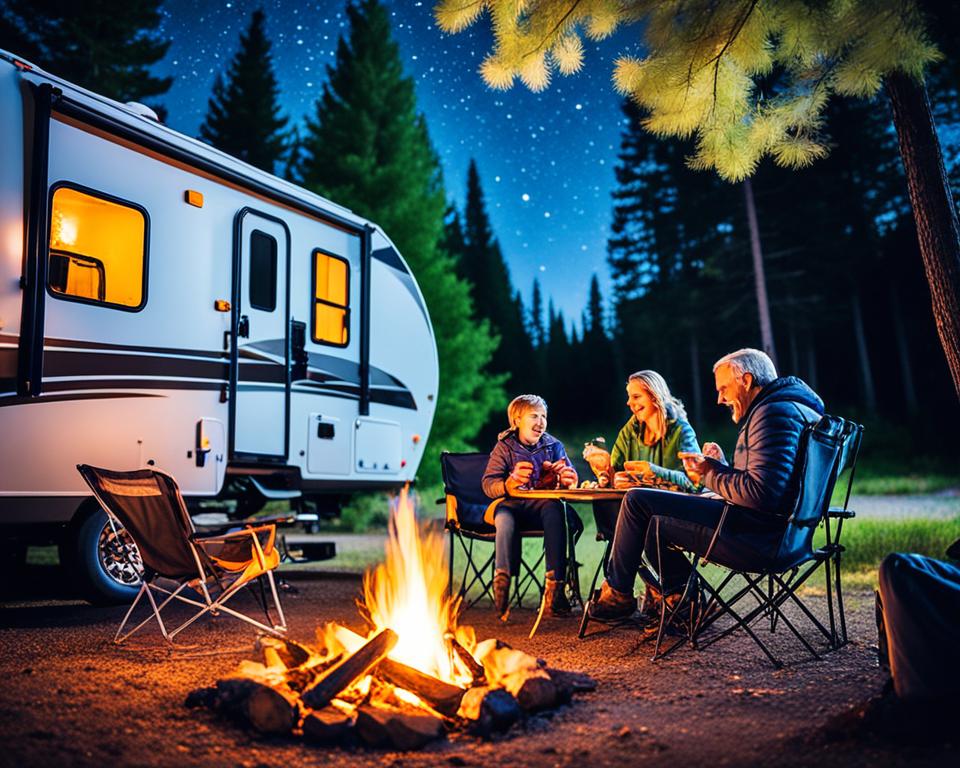
| Benefits of RV Camping | Freedom of RV camping | Comfort of RVs | Advantages over hotels | Family-friendly RV travel |
|---|---|---|---|---|
| Flexibility to travel anywhere | Spacious living areas | Campfires under the stars | Comfortable and convenient for families | |
| Access to nature and scenic routes | Comfortable beds and fully equipped kitchens | Opportunities for outdoor experiences | Ability to bring along essentials | |
| Unforgettable memories and bonding | Amenities like bathrooms and air conditioning | Immersive nature experience | Supportive community environment |
Choosing the Right RV
When it comes to RV camping, choosing the right RV is crucial. There are various types of RVs with different features and benefits. From Class A motorhomes to travel trailers and pop-up campers, each type caters to different preferences and needs. We’ll explore the pros and cons of each type to help you make an informed decision.
Class A Motorhome
A Class A motorhome is a luxurious and spacious option for RV camping. It offers all the comforts of home, including full kitchens, bathrooms, and living areas. With their large size, Class A motorhomes are perfect for long trips and extended stays.
Class B Motorhome
Class B motorhomes, also known as camper vans, are smaller and more maneuverable. They are ideal for solo travelers or couples looking for a compact and versatile RV. Despite their size, Class B motorhomes still offer essential amenities like a kitchen and bathroom..
Class C Motorhome
A Class C motorhome is a mid-sized option that combines the best features of Class A and Class B motorhomes. They are easier to handle than Class A motorhomes while providing more space and amenities than Class B motorhomes. Class C motorhomes are great for small families or groups.
Travel Trailer
A travel trailer is a towable RV that offers the convenience of having a separate vehicle to explore the area once you’ve set up camp. Travel trailers come in different sizes and floorplans, suitable for various group sizes and budgets. They offer a wide range of amenities and can be easily unhitched at the campsite.
Fifth-Wheel Trailer
Similar to a travel trailer, a fifth-wheel trailer is towed by a pickup truck. The unique design of a fifth-wheel trailer includes a raised front section that extends over the truck bed, providing additional space and a more stable towing experience. They are spacious and offer a residential feel with their multiple levels and floorplans.
Pop-up Camper
A pop-up camper, also known as a tent trailer, is a lightweight and budget-friendly option. These campers are compact and foldable for easy towing and storage. When expanded, they offer sleeping quarters and basic amenities, making them a suitable choice for adventurous travelers.
Truck Camper
A truck camper is a compact and versatile RV that fits directly onto the bed of a pickup truck. It provides sleeping quarters, a small kitchenette, and a bathroom. Truck campers are ideal for those who already own a pickup truck and want the convenience of a self-contained RV.
Toy Hauler
A toy hauler is a travel trailer or fifth-wheel trailer that features a dedicated space for storing outdoor gear, such as motorcycles, ATVs, or bicycles. These RVs cater to adventure enthusiasts who want to bring their toys along on their camping trips.
Hybrid Trailer
A hybrid trailer combines the features of a traditional travel trailer with the versatility of tent camping. These RVs feature expandable sections that fold out to provide additional sleeping space, allowing you to enjoy the best of both worlds.
| Type of RV | Pros | Cons |
|---|---|---|
| Class A motorhome | Luxurious and spacious | Expensive and less maneuverable |
| Class B motorhome | Compact and versatile | Limited amenities and space |
| Class C motorhome | Mid-sized and convenient | May be challenging to drive in certain areas |
| Travel trailer | Separate vehicle for exploring | Requires a suitable towing vehicle |
| Fifth-wheel trailer | Spacious and stable towing | Requires a pickup truck for towing |
| Pop-up camper | Lightweight and budget-friendly | Basic amenities and limited space |
| Truck camper | Compact and fits onto a pickup truck | May have limited amenities and space |
| Toy hauler | Dedicated space for storing outdoor gear | Can be heavy and more expensive |
| Hybrid trailer | Combines features of trailers and tents | May require extra setup and takedown time |
Packing Essentials for RV Trips
Packing efficiently for an RV camping trip is essential. To ensure you have all the essentials, we’ve compiled a comprehensive packing list that covers everything you’ll need for a comfortable and enjoyable trip. From kitchen supplies and bedding to safety equipment and entertainment options, here’s what you should pack for your RV adventure:
Kitchen Supplies
- Cooking utensils
- Pots and pans
- Dishes and cutlery
- Can opener
- Coffee maker
- Food storage containers
Bedding and Linens
- Sheets and pillowcases
- Blankets or sleeping bags
- Pillows
- Towels
Toiletries and Personal Items
- Toothbrush and toothpaste
- Shampoo and conditioner
- Soap or body wash
- Deodorant
- Toilet paper
First-Aid Kit
- Band-aids
- Antiseptic ointment
- Gauze pads
- Tweezers
- Pain relievers
- Insect repellent
RV Maintenance and Tools
- Tire pressure gauge
- Jumper cables
- Basic tools (screwdriver, wrench, etc.)
- Duct tape
- Spare fuses
Outdoor and Recreational Gear
- Camping chairs
- Outdoor grill
- Cooler
- Hiking gear
- Bicycles
- Fishing equipment
Safety Equipment
- Fire extinguisher
- Smoke and carbon monoxide detectors
- Emergency flares
- First-aid manual
- Emergency contact numbers
Entertainment and Electronics
- Portable Bluetooth speaker
- Laptop or tablet
- Chargers for electronic devices
- Board games or playing cards
- Books or e-readers
Food and Supplies
- Non-perishable food items
- Bottled water
- Cooking oil and spices
- Coffee or tea
- Snacks
- Trash bags
Miscellaneous
- Extra batteries
- Camera or smartphone for capturing memories
- Sunscreen
- Umbrella
- Cash or credit cards
- Maps or GPS
Having these essential items packed and ready will ensure you’re well-prepared for your RV camping trip. Remember to customize the list based on the duration of your trip, the number of people in your group, and any specific activities you plan to partake in. Happy travels!
Setting Up and Enjoying Your Campsite
Once you arrive at your campsite, it’s time to set up and enjoy your surroundings. Follow these essential steps to ensure a smooth and enjoyable RV camping experience.
Choosing a Campsite
When selecting a campsite, consider factors such as proximity to amenities, scenic views, and privacy. Look for campsites with level ground and sufficient space for your RV and outdoor activities. Research online reviews and recommendations to find the perfect spot.
Parking and Leveling
When parking your RV, choose a level area to avoid stability issues and water drainage problems. Utilize leveling blocks or ramps to achieve a balanced position. Make sure to engage your parking brake and chock the wheels for added safety.
Water and Electricity Hookups
Connect your RV to the campground’s water and electricity hookups for a comfortable stay. Use a potable water hose to fill your freshwater tank, and plug your RV into the electrical pedestal using a compatible RV power cord. Ensure proper connections to avoid any accidents or electrical issues.
Stabilizing the RV
To prevent your RV from rocking or swaying, stabilize it using leveling jacks or stabilizer bars. Test the stability once in place and make adjustments as needed. This will enhance your comfort inside the RV and ensure a stable outdoor living area.
Outdoor Living Area Setup
Create a welcoming outdoor living area by adding outdoor furniture, such as chairs and tables, under your RV’s awning. Use rugs or mats to define your space and provide a clean surface for walking. Add decorative touches like string lights or outdoor speakers to enhance the ambiance.
Safety Precautions
Stay safe during your camping trip by following some essential safety precautions. Keep a fire extinguisher handy and know how to use it. Be cautious with campfires and ensure they are fully extinguished before leaving. Familiarize yourself with any campground or local safety procedures.
Organization Tips
To make the most of your RV’s limited space, stay organized. Use storage containers and organizers to keep your belongings tidy and easily accessible. Utilize vertical space by installing hooks or shelves. Keep frequently used items within reach and secure loose objects before hitting the road.
By following these tips and setting up your campsite properly, you’ll be ready to relax and enjoy your RV camping adventure to the fullest.
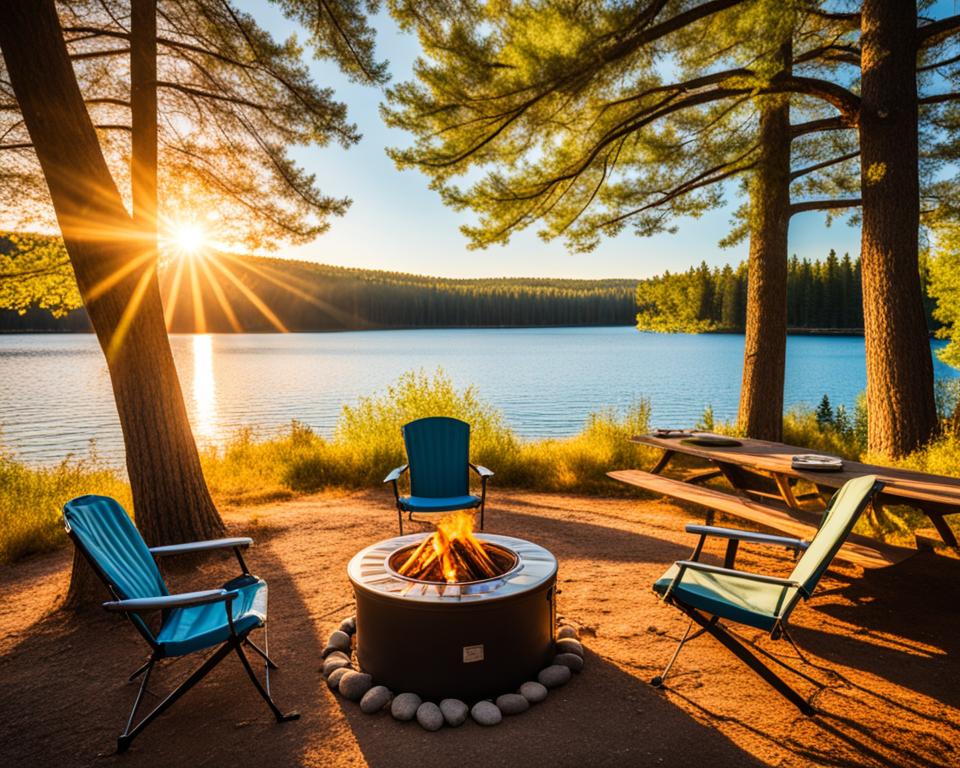
Conclusion
RV camping offers endless opportunities for adventure and outdoor exploration. With the right planning, equipment, and mindset, you can create unforgettable memories on your RV camping adventures. Whether you’re a beginner or an experienced traveler, this ultimate guide has provided you with valuable information and inspiration for your next RV camping trip.
From discovering dispersed camping and finding the perfect campsite to understanding the rules and regulations, preparing for primitive camping, choosing the right RV, and packing essentials, every aspect of RV camping has been covered. You now have the knowledge to confidently embark on your own RV camping adventure, equipped with the necessary tools and resources.
As you venture into the great outdoors, remember to embrace the freedom that RV camping offers and enjoy the comfort of your home on wheels. Take advantage of the flexibility it provides, allowing you to connect with nature and create lasting memories with your loved ones. So grab your gear, plan your route, and get ready for an amazing RV camping adventure!
Happy camping!
FAQ
What is dispersed camping?
Dispersed camping, also known as boondocking, is camping outside of designated campgrounds on public lands managed by agencies like the Bureau of Land Management (BLM) or United States Forest Service (USFS).
How do I find dispersed campsites?
You can use mapping platforms like Gaia GPS or websites like Campendium, FreeCampsites, iOverlander, and The Dyrt to find information and reviews about potential dispersed campsites.
What should I consider when looking for a dispersed campsite?
Factors to consider include proximity to water, trails, or cell service based on your preferences.
How should I prepare for the road conditions when camping in dispersed areas?
It’s important to research your destination and consider whether your RV is capable of navigating rough roads. Smaller trailers offer more maneuverability, and carrying traction tire mats is advisable in case of encountering sand or mud.
What are the rules and regulations for dispersed camping?
Each land manager has different rules. For example, the BLM allows camping for up to 14 days in one spot. It’s essential to check the specific rules ahead of time, including any fire regulations, and follow Leave No Trace ethics.
What do I need to know about primitive camping with an RV?
Primitive camping means being self-sufficient without hookups. Consider your RV’s power usage, freshwater, gray water, and black water tank capacities. It’s advisable to have extra drinking water and a leveling kit for uneven sites.
What are the benefits of RV camping?
RV camping offers the freedom to travel and be comfortable in a miniature version of your home. Advantages include the ability to have campfires under the stars and more outdoor experiences, making it a popular choice for families.
What types of RVs are available for camping?
There are various types of RVs, including Class A motorhomes, travel trailers, pop-up campers, truck campers, and more, each catering to different preferences and needs.
What should I pack for an RV camping trip?
You should pack essentials like kitchen supplies, bedding, toiletries, first-aid kits, RV maintenance tools, outdoor gear, safety equipment, entertainment options, and food. A comprehensive packing list is recommended.
How do I set up and enjoy my RV campsite?
When you arrive at your campsite, you should choose a suitable location, park and level your RV, connect to water and electricity hookups, stabilize your RV, set up an outdoor living area, take safety precautions, and organize your belongings inside the RV.
What should I consider when choosing an RV for camping?
Factors to consider include the type of RV, such as motorhomes or trailers, and their specific features and benefits. Personal preferences and needs play a significant role in choosing the right RV.

